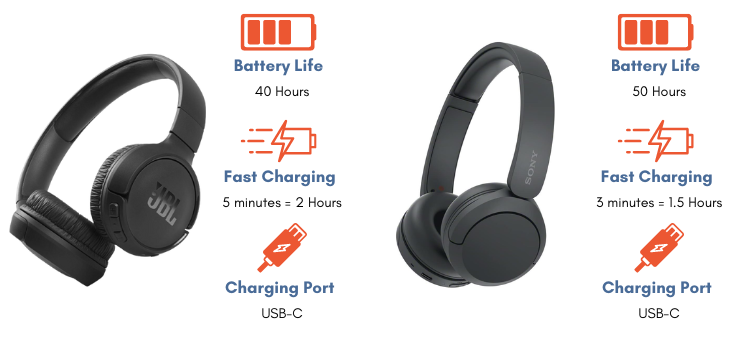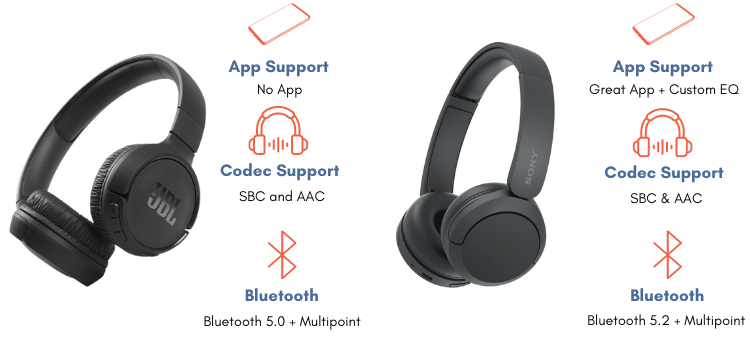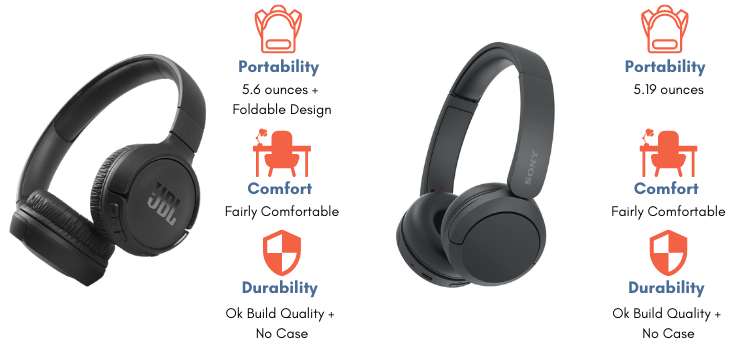Navigating the maze of choices for budget wireless headphones? You likely came across these two options. Today, we’re turning the spotlight on two compelling contenders: the bass-rich JBL Tune 510BT and the feature-packed Sony WH-CH520. Stay tuned as we delve into all the features and specs you need to make a good buying decision.
Table of Contents
Comparison Table: Sony WH-CH520 vs JBL Tune 510BT
| Features | JBL Tune 510BT | Sony WH-CH520 |
|---|---|---|
| Type of Headphones | On-Ear | On-Ear |
| Weight | 5.6 oz | 5.19 oz |
| Total Battery Life | 40 hours | 50 hours |
| ANC Support | No | No |
| Wired Connection | No | No |
| Fast Charging | 5-minute charge = 2 hours | 3-minute charge = 1.5 hours |
| Charging Port | USB-C | USB-C |
| Bluetooth Version | 5.0 | 5.2 |
| Bluetooth Multipoint | Yes | Yes |
| Codec Support | SBC, AAC | SBC, AAC |
| App Support | No | Yes |
| Customizable EQ | No | Yes |
| Included Case | No | No |
Which Headphones Have Better Battery Life?

When it comes to battery life, both the JBL Tune 510BT and Sony WH-CH520 offer impressive performance that will satisfy even the most demanding listener. The JBL Bluetooth headphones provide around 40 hours of playback, while the Sony set lasts an astounding 50 hours on a single charge. For those who need their headphones to work overtime, the extra 10 hours of longer battery life on the Sony model is a clear advantage for office workers, travelers, and anyone prone to battery anxiety.
Looking at charging capabilities, both models include fast charging features to quickly juice up the battery when you’re short on time. The JBL allows 2 extra hours of playback from a 5-minute charge, while the Sony adds 1.5 hours from just 3 minutes of charging. This kind of speedy top-up is perfect for people on the go who want their headphones ready to perform at a moment’s notice.
In terms of charging ports, the JBL and Sony wireless headphones are evenly matched with USB-C connectors. This newer, universal port allows convenience and compatibility across devices without the hassle of legacy cables and adapters. Overall, while the stellar 50 hours of battery life gives Sony an edge, both headphones provide impressive uptime and fast charging for their price. Consumers can’t go wrong with either option when looking for a high amount of battery life on a single charge.
Connectivity & App Support

Good connectivity shouldn’t be relegated to high-end products. Reliable Bluetooth performance is an especially crucial aspect to consider while choosing your perfect set of headphones. The JBL Tune 510BT and Sony WH-CH520 both perform well in this regard. Sony’s WH-CH520 comes with Bluetooth 5.2, while the JBL Tune 510BT offers Bluetooth 5.0. You’ll find both are quick when pairing new devices and maintain a strong connection.
Both headphones showcase a very helpful Bluetooth Multi-point feature, allowing you to stay connected with multiple devices simultaneously. Being able to switch back and forth between two Bluetooth devices is great for productivity purposes. This multi-device connection is particularly handy for multitaskers juggling between their smartphone and laptop.
In terms of audio codec support, both wireless on-ear headphones have compatibility with standard SBC and AAC codecs, ensuring consistent wireless audio quality for common devices. Although neither of them supports the LDAC codec, known for its superior audio quality, it’s important to note that this matters only to those with the files and devices to take advantage of it.
The absence of a wired connection option on both devices reiterates Sony and JBL’s intent to focus on lightweight, affordable headphones. But if you’re someone who still likes to plug in to experience lossless audio or when your battery runs dry, these may not be your go-to choices. Both headphones do have a built-in microphone for phone and Zoom calls.
Where the Sony WH-CH520 truly stands apart, though, is with its accompanying Sony Headphone Connect App. This versatile companion lets you customize your EQ settings, adding an extra layer of personalization to your sound settings. The app can also be used to facilitate future updates on the headphones and possibly add features. Unfortunately, the JBL Tune 510BT does not offer a comparable feature, making the Sony WH-CH520 a better option if you want to get the most out of your headphones.
Comparing Design: JBL Tune 510BT vs Sony WH-CH520

Weighing a mere 5.6 ounces, the JBL Tune 510BT is a very lightweight pair of headphones. Impressively, the Sony WH-CH520 weighs slightly less, at approximately 5.19 ounces. The Sony headphones may offer a little more convenience for portability and comfort. In terms of build, both wireless headphones share a lightweight design that promotes portability. The JBL Tune 510BT folds inward for compact storage and lies flat, while the Sony WH-CH520 can only be flattened. However, it’s worth noting that neither headphone includes a protective case or bag.
When it comes to comfort, the Sony WH-CH520 and JBL 510BT, with their lightweight design and faux leather-covered cushioning, make decent companions for those long listening sessions. Both offer a decent amount of cushioning, although the JBL 510BT’s headband doesn’t offer cushioning all the way across. Unlike over-ear headphones, the on-ear design doesn’t offer as much room within the ear pad. For this reason, they can be slightly less comfortable for those with bigger ears or glasses. The on-ear design and the fabric surrounding the ear cups might cause discomfort over time and create some unwanted noise when moved.
Aesthetically, the JBL Tune 510BT and Sony WH-CH520 offer a pretty simple design. While I wouldn’t describe it as sleek, the Sony WH-CH520 looks a little more modern. The build quality on both headphones is fine, but the plastic does, as expected, feel cheaper than the material on more expensive headphones. Both wireless headphones offer 4 colors. You can find the JBL headphones in black, white, rose, and blue. The Sony WH-CH520 is available in black, blue, beige, and white.
Both headphones come with physical button controls on the right earcups. Controls on both are easy to use, with playback controls, call control, volume control, and the ability to activate your voice assistant of choice. In summary, both offer a subtle style, a lightweight design, and decent comfort. Design isn’t the strong point of either, as build quality typically suffers most at such a low price point. Excellent value comes with some drawbacks.
Sound Quality Faceoff: Big Bass vs Neutral EQ
Sound quality is important, no matter the price. It’s also important to remind readers that these are budget headphones. Audiophile performance should not be expected.
The Sony WH-CH520 and JBL Tune 510BT offer default EQs with enough distinction to aid a buying decision. With the JBL Tune 510BT, users will definitely find them to be the more bass-heavy headphones. Bass is overemphasized enough that it can overpower the vocals on bassier songs. Meanwhile, the mids are neutral, helping vocals remain present. Lastly, you’ll find the treble a little elevated. All around, it’s a V-shaped sound with powerful bass and clear highs that many non-critical listeners enjoy. The added thump of bass can also add another dimension to exercise, as many prefer a louder, punchier sound to keep their energy high. Unfortunately, the JBL Tune 510BT doesn’t offer support for a companion app to more easily customize the EQ. Without a 3rd party solution, users will be stuck with this default, bassy EQ.
On the contrary, the Sony WH-CH520 wireless headphones showcase a very balanced sound signature. Its bass frequencies remain neutral and accurate, delivering punch without impacting the clarity of the mid-range and higher frequencies. Vocal presentations are strikingly clear with an accurate midrange, meaning singers and instrumentalists take center stage without getting clouded. However, the high-frequency range of the Sony WH-CH520 is slightly underemphasized, which might make some instruments sound less crisp. Luckily, the Sony WH-CH520 is supported by the Sony Headphones Connect app, which offers EQ customization in addition to EQ presets and Clear Bass.
As you can see, the JBL Tune 510BT might get your head nodding with its bass-forward approach, catering to bass heads and workout warriors. Conversely, the Sony WH-CH520 delivers more balanced sound reproduction by default. But the option to tweak the EQ via the Sony app does give the Sony WH-CH520 a slight leg up. Given these differences, listeners might prefer one over the other based on personal tastes, your use case, and the music genres they typically enjoy.
Do the JBL Tune 510BT or Sony WH-CH520 Have Active Noise Cancelling?
When looking for an uninterrupted audio experience, active noise-cancelling features on headphones can be a lifesaver. Unfortunately, neither the JBL Tune 510BT nor the Sony WH-CH520 support active noise cancelling (ANC) capabilities. Users seeking the best ANC headphones for every budget can check out our guide with complete recommendations.
Are The Sony WH-CH520 vs JBL Tune 510BT Better Budget Headphones?
Choosing between the JBL Tune 510BT and Sony WH-CH520 hinges on individual preferences and specific needs. Both are lightweight and very affordable, with good battery life. If you prefer a bass-heavy sound and a simpler design, the JBL might be preferable. But if balance and crisp vocals are what you crave, then the Sony is the better pick. The Sony headset is also a better option for those who prioritize app support and EQ customization.
Nevertheless, the absence of active noise cancellation and the build quality remind us that these headphones are affordable headphones that aren’t perfect. So, weigh your options, consider your priorities, and pick the one that best fits your use case.
Feature Comparison: JBL Tune 510BT vs Sony WH-CH520
Headphone Design:
Both the JBL Tune 510BT and Sony WH-CH520 are on-ear headphones. On-ear headphones balance comfort and sound quality with a lighter form factor.
Weight:
The JBL Tune 510BT weighs 5.6 ounces, while the Sony WH-CH520 weighs 5.19 ounces, making them both extremely lightweight choices. Lightweight headphones can make long periods of music playback more comfortable.
Active Noise-Cancelling:
Neither the JBL Tune 510BT nor the Sony WH-CH520 come equipped with active noise cancelling. This feature usually helps to remove background noise, enhancing the listening experience. But, their on-ear design should provide some level of passive noise isolation.
Passive Playback:
Both the JBL Tune 510BT and Sony WH-CH520 do not support passive playback with a wired connection. Although the wireless design allows for mobility and convenience, a wired connection option often delivers superior audio quality, with no need for battery power.
Supported Codecs:
JBL Tune 510BT and Sony WH-CH520 both support SBC and AAC codecs. Codecs play a vital role in how Bluetooth is transmitted from the source to your headphones. SBC and AAC codecs ensure good sound quality, but neither headphone supports the higher-quality LDAC codec.
Fast Charging:
Both headphones come equipped with fast charging, which is a convenient feature for commuters and travelers. The JBL Tune 510BT has a slight edge here, as a quick 5-minute charge delivers an extra 2 hours of playback, while a 3-minute charge on the Sony WH-CH520 yields about 1.5 hours of playback.
Charging Connection:
Both headphones employ a USB-C charging port, aligning with the latest standard in device charging. This allows for faster charging and a reversible plug design, enhancing user convenience.
Bluetooth Connectivity:
Bluetooth technology enables these headphones to connect wirelessly to your devices. While the JBL Tune 510BT operates on Bluetooth 5.0, the Sony WH-CH520 boasts Bluetooth 5.2 technology. Both headphones also support Bluetooth Multipoint, which allows for simultaneous connection to multiple devices.
App Support:
The Sony WH-CH520 edges out in this category, supporting a companion app, Sony Headphone Connect, with EQ customization. Having a companion app can enhance the user experience, providing options for personalizing sound profiles. Unfortunately, the JBL Tune 510BT does not offer app support.
Included Case:
Neither of these wireless headphones comes with a case. While not a necessity, an included case provides protection and easy portability for your headphones.

Keith Collins has been writing for over 15 years for various publications. He’s a lover of music, home theater, and excellent sound quality. His fondness for technology in addition to his non-stop curiosity fuels his writing ventures.







